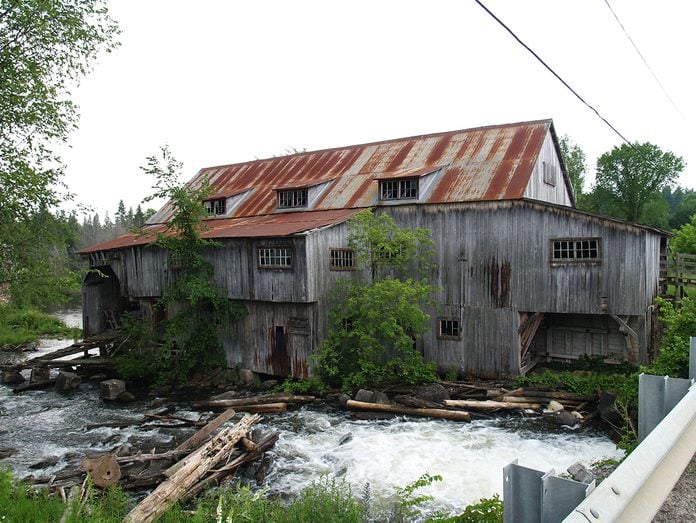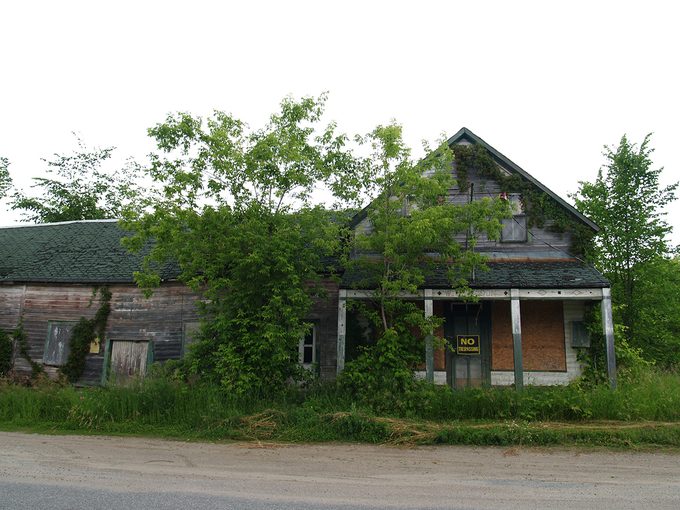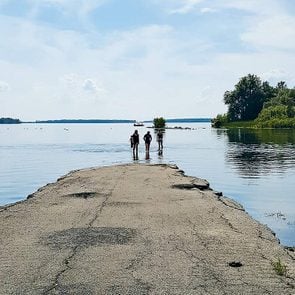Ontario’s Most Famous Ghost Town Might Disappear Soon

Located about four hours east of Toronto, the town of Balaclava has rightfully earned its place in Canadian ghost town lore. Here’s a look at its fascinating history.
Ontario is home to more than 200 ghost towns, but few are as famous as Balaclava. Situated in Renfrew County in Eastern Ontario, the site is well-known for its rundown sawmill (above), which sits along a shallow river and is surrounded by rotting tree logs, pieces of machinery and wagon wheels.
Intrigued visitors can find this town on Scott Bush Road, just north of the community of Dacre. Unsurprisingly, Balaclava has for years been a favourite destination for urban explorers and photographers alike.
“There are a couple reasons for the appeal of ghost towns,” says Ontario historian and author Ron Brown. “They recall those days of yore when we saw those tumbleweed ghost towns in cowboy movies, but to me and others, it’s also the appeal of finding artifacts or just getting the sense that there was once a place here, with people and businesses.”
The Rise and Fall of Balaclava, Ontario
The town takes its name from the Battle of Balaklava, a skirmish during the Crimean War in the 1850s. In its heyday, Balaclava was a flourishing lumber town that produced up to one million board feet of lumber per week. The sawmill at the heart of the community, one of Ontario’s last water-powered mills, was erected in 1855. It was partially destroyed by a fire in 1936 but rebuilt three years later. The structure remains standing to this day, but in such a state of disrepair, it’s best to admire it from afar.
Balaclava was also the site of Ontario’s first-ever environmental lawsuit, says Brown. The Richards family bought the sawmill in 1868, but in 1911, they were taken to court when a nearby grist mill complained that the family was disposing too much sawdust into the river. The grist mill won the case, and the Richards were required to pay $200 USD in restitution. The lawsuit also resulted in the addition of a sawdust burner.
By the mid-1950s, depleted timber supply in surrounding areas meant the sawmill was only producing a few thousand board feet every year. Soon, it was forced to shut down, along with Balaclava’s general store. (A host of other shops and businesses had already shuttered several years earlier.) Bypassed by railways and with its only industry gone, Balaclava—once home to approximately 200 residents—was abandoned. In the following years, town staples like the general store, blacksmith shop (below), two hotels and sawmill, either burned down, were dismantled or fell into decay.
Brown has been researching Ontario’s ghost towns, railways and unusual attractions for more than 40 years. The 75-year-old Toronto resident first visited Balaclava in the summer of 1996, and then again in August 2018.
On his first visit to Balaclava, Brown remembers a lovely row of wooden buildings and houses with still-intact porches lining the main street, describing it at the time as a “classical ghost town.” But on his second visit, he recalls Balaclava’s atmosphere felt more sad than eerie—in contrast with the notion that ghost towns are haunted and hair-raising sites.

Balaclava Today
Balaclava’s crumbling remains are something visitors may want to catch before they’re lost to the elements or rebuilt. In fact, the latter is slowly taking place. The collapsing attachment to the general store, for instance, was torn down and the building made into a hunting camp.
“There was an initiative maybe 15 years ago to preserve [the sawmill], but the property owners didn’t want anything to do with that,” says Brown. “We do not have very good heritage preservation standards in this province, so [the sawmill] sits, falling apart.”
That’s right: the sawmill is currently privately owned, with reports of threats to demolish it if people continue trespassing. According to Brown, there are also a few occupied homes in the general area of Balaclava.
Since the abandoned buildings are still private property, Brown says those who want to visit Balaclava should be mindful. Ask the sawmill’s owner—likely to be found in the nearest building to the mill—for permission first if you want to get a closer look. It also doesn’t hurt to try and strike up conversations with nearby residents, Brown says.
“My mission is to encourage people to explore the heritage which is in their own backyards, whether it’s a built heritage like mills or ghost towns, or geological heritage,” he says. “And there’s a lot of that out there too, which is quite fun.”
Now that you know the story of Balaclava, Ontario, check out 10 Canadian castles worth exploring.






